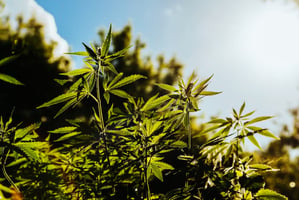A landmark new bill that would legalize marijuana would also create a legal pathway for the use of...
Hemp Industry Pivots Toward Grain & Fiber

After a brutal shake-out that chopped hemp acreage in half in just two years, the industry is focusing on hemp as a source of grain and fiber, a less profitable but possibly steadier market than cannabinoid (CBD) oil, used in food, beverages, and dietary supplements. Analysts say the unclear regulatory status of CBD has throttled sales.
Growers rushed into industrial hemp following legalization of the crop by the 2018 farm bill, attracted by reports of high revenue from hemp sold for processing into CBD oil. But the pandemic and a glut of hemp crushed wholesale prices.
Licenses were issued for only 285,000 acres in 2021, down from as many as 466,000 acres in 2020 and more than 511,000 acres in 2019, when production was the highest ever, reported Hemp Industry Daily.
The Hemp Industry 2022 Opportunity Report said licensed acreage fell by 55% “to levels seen before the 2018 farm bill.” The 2014 farm law allowed hemp pilot and research programs.
CBD prices fell below production costs but the “bright spot was the supply and demand for fibers and grain,” said the report. “We’re only at the beginning of the renaissance of hemp.” Economist Beau Whitney, a contributor to the report, said “plantings of hemp for grain and fiber are expected to exceed CBD acreage by 2024-25.”
Wendy Mosher of New West Genetics, a developer of hemp seed, told Hemp Industry Daily that demand was rising for seed to grow hemp for fiber. “We’re seeing the swing from CBD to fiber.” Mosher also was optimistic about the potential market for hemp grain.
The USDA is scheduled to release its first National Hemp Report on February 17, with data on planted and harvested area, yields per acre, production, and value of industrial hemp, based on a survey sent to 20,500 producers. “The report will form a benchmark for the crop and help farmers decide how much and what type of hemp to grow,” said Kevin Barnes, of USDA’s statistical agency. “Until now, analysts have relied on license data from states and rudimentary data from USDA.”
By law, industrial hemp cannot contain more than 0.3% of the tetrahydrocannabinoil, the psychoactive substance in marijuana.
Based on interest by farmer and processors, two hemp trade groups said last year that they would collaborate on a proposal for a check-off program to pay for research and promotion of industrial hemp. The USDA currently operates 21 checkoff programs for commodities ranging from cotton to mangoes.
EDITOR’S TAKE:
Apparently “irrational exuberance” isn’t limited to the stock market. It’s only natural that farmers want to experiment with new market opportunities. When markets are being formed initially, it is often difficult to have the predictability of more established pricing and data infrastructure. As often happens in these types of scenarios, they adjust. Precisely, that is what is occurring with industrial hemp. New opportunities are afforded with grain and fiber sub-markets and the increasing emphasis of establishing research and promotional capabilities that will continue to assist producers as the industry matures. It is not uncommon to see this pathway develop for new or, in this case, a re-established commodity, which is still farming related and still needs trucks, parts and service from CAD members. Don’t overlook the breadth and depth of what agriculture encompasses.








